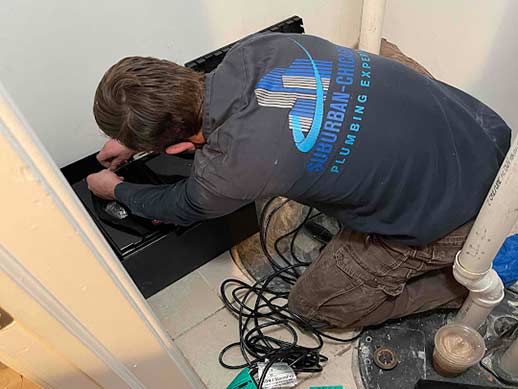Understanding the Importance of Sump Pumps in Basement Flood Prevention
Basement flooding can be a homeowner’s worst nightmare. The damage caused by water can be extensive, leading to costly repairs and potential health hazards such as mold growth. A sump pump is an essential tool in preventing basement flooding. It works by collecting and pumping out excess water that accumulates in a sump basin, usually located in the lowest part of the basement. Understanding the importance of sump pumps and their role in flood prevention is the first step in protecting your home.
Regular Sump Pump Maintenance: The Key to Longevity and Efficiency
Regular maintenance is crucial to ensure your sump pump operates efficiently and has a long lifespan. Without proper maintenance, your sump pump may fail when you need it the most. Here are some essential maintenance tasks to keep your sump pump in top condition:
Inspect the Pump and Basin: Regularly check the sump pump and the basin for any debris, dirt, or obstructions that could impede its operation. Clean the basin and remove any debris to ensure smooth functioning.
Test the Pump: Periodically test the sump pump by pouring water into the basin to see if it activates and pumps out the water. This will help you identify any potential issues before they become serious problems.
Check the Power Source: Ensure that the sump pump is properly connected to a power source and that the electrical connections are secure. Consider using a dedicated circuit to avoid overloading other appliances.
Inspect the Discharge Pipe: Make sure the discharge pipe is free from clogs and is directing water away from your home’s foundation. This will prevent water from seeping back into the basement.
Backup Power Solutions: Ensuring Continuous Operation During Power Outages
Power outages often accompany severe storms, which is precisely when you need your sump pump the most. To ensure continuous operation of your sump pump during power outages, consider implementing backup power solutions:
Battery Backup Systems: A sump pump battery backup system installation can keep your sump pump running for several hours during a power outage. It’s an essential investment for homeowners in areas prone to heavy rainfall and storms.
Water-Powered Backup Pumps: These pumps use the pressure from your home’s water supply to operate, providing an additional layer of protection in case of power failure. They are a reliable alternative to battery backup systems.
Generator Backup: A portable generator can provide power to your sump pump and other essential appliances during an extended power outage. Ensure you have enough fuel and know how to operate the generator safely.
Upgrading Your Sump Pump: When and Why It’s Necessary
Over time, sump pumps can wear out and become less effective. Upgrading your sump pump may be necessary to ensure optimal performance and protection against flooding. Here are some signs that it might be time to upgrade your sump pump:
Age of the Pump: Sump pumps typically last around 7-10 years. If your pump is nearing the end of its lifespan, consider replacing the sump pump it with a newer, more efficient model.
Frequent Cycling: If your sump pump is constantly turning on and off, it may be struggling to keep up with the water intake. Upgrading to a more powerful pump can help manage the water more effectively.
Increased Water Volume: Changes in your home’s drainage system or increased rainfall in your area may result in higher water volumes. An upgraded sump pump with a higher capacity can handle the increased load.
Noise and Vibration: Excessive noise and vibration during operation can indicate that your sump pump is working harder than it should. A newer model can provide quieter and more efficient performance.
Professional Sump Pump Inspection and Installation: Ensuring Optimal Performance
While regular maintenance and testing can be done by homeowners, professional inspection and installation of sump pumps can ensure optimal performance and longevity. Here are some benefits of hiring a professional:
Expertise and Experience: Professional plumbers have the expertise and experience to identify potential issues and provide solutions that homeowners may overlook.
Proper Installation: Ensuring that your sump pump is installed correctly is crucial for its performance. Professionals can install the pump and related components according to industry standards and best practices.
Comprehensive Inspection: A professional inspection can identify any underlying issues with your sump pump system, including the basin, discharge pipes, and power source. This can prevent future problems and costly repairs.
Peace of Mind: Knowing that your sump pump has been professionally inspected and installed provides peace of mind, especially during severe weather conditions. You can trust that your basement is well-protected against flooding.
Additional Tips for Maintaining a Dry Basement
In addition to maintaining your sump pump, there are other steps you can take to keep your basement dry and prevent flooding:
Proper Grading: Ensure that the ground around your home slopes away from the foundation. This will help direct water away from your basement and reduce the risk of flooding.
Gutter and Downspout Maintenance: Regularly clean and maintain your gutters and downspouts to ensure they are directing water away from your home’s foundation. Clogged gutters can lead to water overflow and seepage into the basement.
Seal Cracks and Gaps: Inspect your basement walls and foundation for any cracks or gaps. Seal them with waterproof sealant to prevent water from seeping in.
Install a Dehumidifier: A dehumidifier can help reduce moisture levels in your basement, preventing mold growth and maintaining a dry environment.
Conclusion: Taking Proactive Steps to Protect Your Home
By understanding the importance of sump pumps, performing regular maintenance, implementing backup power solutions, and considering professional inspection and installation, you can stay ahead of flooding and keep your basement dry. Taking these proactive steps will not only protect your home from water damage but also provide peace of mind during severe weather conditions. Remember, a well-maintained sump pump is your first line of defense against basement flooding.


